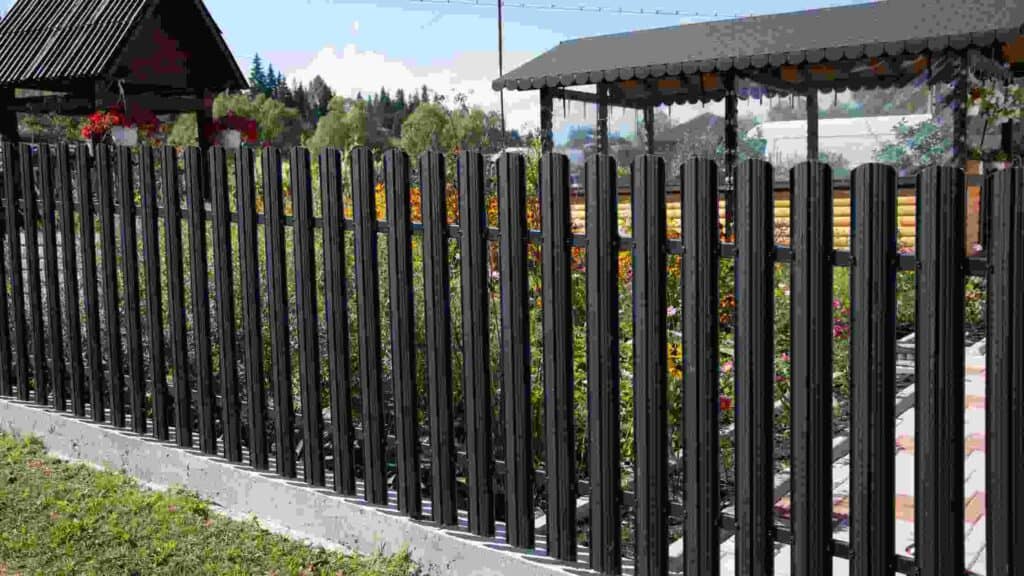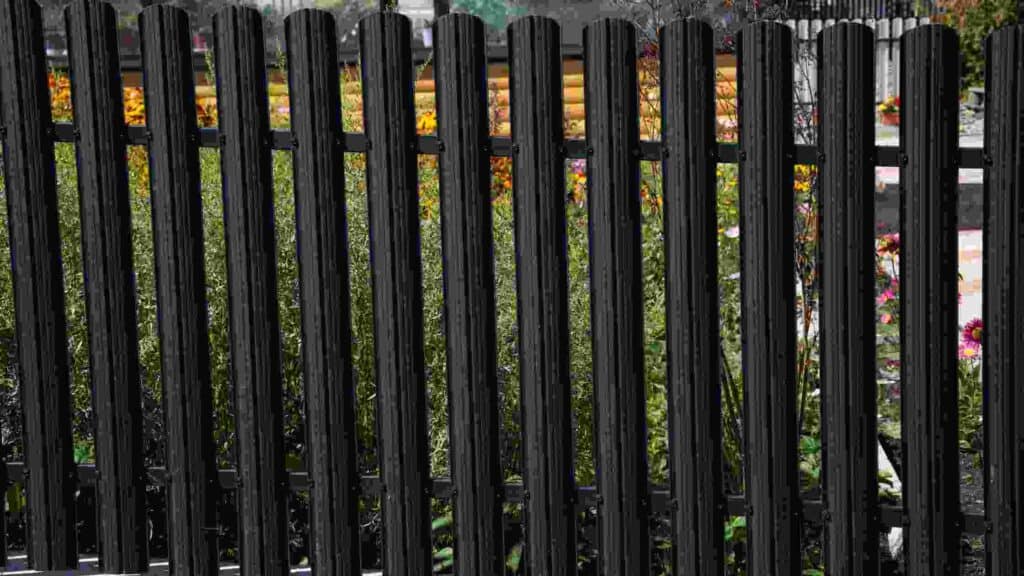In this article, we’ll walk you through a comprehensive guide on how to install an aluminum fence, from the prerequisites to the materials required and the actual installation process.
Installing an aluminum fence might sound like a daunting task, but fear not! With some proper preparation and planning, you’ll be well on your way to fence installation success.
How To Install An Aluminum Fence
Now, don’t get overwhelmed with all the planning and measurements – help is just a click away!
Many companies provide excellent online support to help you plan and order your aluminum fencing materials. With the guidance of their software and customer service professionals, you can visualize the fence in place before even starting.
Just input your measurements, including gate requirements, and the software will calculate the exact number of posts and panels needed.
Of course, it’s vital to double-check your measurements to avoid delays caused by ordering extra materials. And hey, while you’re browsing online, you can also check out the array of colors and grades of aluminum fencing available.
1. Materials Required For Aluminum Fence Installation

Now, let’s gear up with the right materials before getting our hands dirty. When planning your aluminum fence, consider corner posts, end posts, line posts, and gate posts.
End posts have holes on one side and serve as starting and stopping points, while corner posts have holes on adjacent sides, allowing you to create right angles.
Line posts, on the other hand, have holes on opposite sides and are perfect for straight fence runs. As for the panels, they typically come in 6-foot lengths, so keep that in mind when measuring. And, if you need to cover a 10-foot stretch, just allow for 2 panels.
Gates? For driveways, you’ll need a double gate, while a single gate will do the job for walkways. And here’s a pro tip: some companies offer panels in different lengths and widths, so consider that while ordering.
2. Tools Of The Trade: Equipping Yourself For Success
Before we jump into the installation process, let’s make sure we have all the tools we need. Here’s a handy list of things to secure before you start:
- Concrete mix and mixer
- A post-hole digger
- Long level
- Shovel and hoe
- Hacksaw
- Stakes and string
- Rubber mallet
- Drill or Screwdriver
- Hammer
If you don’t have some of these tools, don’t worry; you can rent them if needed.
3. Planning The Layout: Mapping Out Your Fence
Before diving into the actual installation, let’s start with a well-thought-out plan for your aluminum fence.
First things first, measure the area you want to fence and place stakes at intervals where you’ll dig post holes. Think ahead and mark where gates and corners will be needed.
To visualize the fence’s layout, tie strings between the corner stakes to define where the posts will go. It’s crucial that all the stakes are in sync with the string – precision is key!
4. Digging The Post Holes: How To Put Up An Aluminum Fence
Now, let’s get those posts in the ground! For each aluminum post, you’ll need a 6-inch diameter hole, about 2 feet deep.
But hold your post-hole digger for a moment! Safety first – locate any telephone lines or underground cables in the area to avoid any unwanted accidents.
Once you’re sure it’s clear, proceed with the digging. The soil type will play a role in how easy or challenging this task will be, so brace yourself accordingly.
For those long stretches of the fence, plan the number of sections and distribute them evenly, ensuring it all fits well. If you have a vast area to fence, consider hiring an auger to save you some effort.
Remember, the closer to the house, the better for end posts, but make sure they don’t actually touch the house. If there’s more than a 4-inch gap, you’ll need wall mounts to attach the end posts securely.
Now, let’s talk about securing those posts. A wet-set concrete mix works wonders, providing a solid anchor system for each post.
Here’s a pro tip: pre-dig the holes and assemble 3-4 fence sections with their respective posts on the ground. Stand them all up at once, place them in the pre-dug holes, and then do the concrete mix for 3-4 holes at once.
One last thing – make sure the screw heads face toward the property. We wouldn’t want those sharp edges on the outside, right?
Know Your Boundaries

Before diving into the installation process, it’s crucial to know the exact location of your property boundaries. Take your time to mark them accurately to ensure that your fence sits right where it should.
Also, keep an eye out for any easements that might limit your fence’s design and placement. To avoid potential conflicts, check your local by-laws regarding fence size and height regulations.
Don’t forget to involve your neighbors in the planning, and you might even consider sharing the cost with those directly adjacent to your property.
Just be aware that depending on your area’s regulations, you might need to apply for a building permit.
Is Aluminum Fencing Durable?
Now, let’s talk about why aluminum fencing is an excellent choice. Compared to other options, installing an aluminum fence is relatively easy, which is great news for DIY enthusiasts.
Besides, aluminum fences are incredibly robust and require minimal maintenance, saving you time and effort in the long run.
The best part? Aluminum fencing is versatile enough to fit into different landscapes and comes in various colors to match your style. Whether you need a fence for your backyard or front yard, or to secure your pool area, aluminum is a good choice.
And let’s not forget about our furry friends and little ones – aluminum fences work wonders as enclosures for dogs and safe play areas for children.
Factors That Affect The Cost To Install Aluminum Fence
Now, it’s essential to remember that a few factors can influence the overall cost of your aluminum fence project. Here’s what to consider:
- Obstacles: Dealing with trees, removing old fencing, rocks, roots, or other obstacles can raise the cost.
- Location: Depending on where you live, additional costs for delivery or professional installation may be incurred, like travel time and fuel expenses.
- Time of Year: Consider the season you want the fence built. Installation companies might offer better deals during less busy periods, avoiding potentially bad weather months or high rainfall.
- Leveling the Ground: Modifying the fence configuration or ground level may increase the overall time and cost taken for completion.
How Much To Install An Aluminum Fence?
The inevitable question – how much will this aluminum fence cost? Well, there are a few factors to consider. Professional installation costs for aluminum fencing can vary per foot or for every 100 feet.
The total price will depend on the style you choose, the fence’s height, and the complexity of the installation. Don’t forget that tricky sloping properties or obstructions like large rocks and trees can make the installation a bit more challenging (find out what to plant along fence line).
Now, if you’re a DIY enthusiast looking to tackle the project yourself, you can save on labor costs but will need to invest in the materials.
The price of aluminum fence materials will vary depending on metal strength, style, fence height, and the number of posts and gates you’ll need. It’s all about finding the right balance between your budget and the fence of your dreams.
Below you can get a rough idea of different pricing options:
Aluminum Fence Cost Breakdown

Budgeting wisely ensures you get the fence you want without breaking the bank.
So, here’s a breakdown of the average costs for a 120 linear feet aluminum fence, whether you go the DIY route or hire a pro:
Low Estimate: DIY for $2,500 – $3,000
For the DIY enthusiasts out there, this option allows you to save on labor costs.
You can expect the average cost per linear foot to be around $25 to $30. With the fence height ranging from 2.5 to 4 feet, it’s a relatively simple project.
Keep in mind that you’ll need to invest around $200 to $250 in supplies and possibly an additional $100 to $200 for surveys and permits.
Average Cost Estimate: DIY or Pro for $3,000 – $4,500
Here’s a more flexible option, suitable for both DIY enthusiasts and those who prefer to hire a professional. The per linear foot cost might go up slightly from $30 to $35, depending on your choices.
With a fence height of 3 to 5 feet, it provides a bit more privacy. Supplies will run you around $300 to $450, and again, expect survey and permit costs to be between $100 and $200.
High Estimate: Pro Installed for $4,500 – $6,000
If you want the pros to handle it all, this option is for you. The per linear foot cost may increase from $35 to $45, but you’ll have a beautiful fence standing tall at 4 to 6 feet high.
Supplies will still be in the range of $300 to $450, and surveys and permits will cost the same as the previous option.
FAQs
1. Can you install an aluminum fence yourself?
Yes, you can install an aluminum fence yourself. It requires some basic knowledge of fence installation and tools, but with proper planning and care, it is achievable for many homeowners.
2. How hard is it to put in an aluminum fence?
Installing an aluminum fence can be moderately challenging but manageable with proper tools and instructions.
3. Do you set aluminum fence posts in concrete?
Yes, aluminum fence posts are typically set in concrete for stability.
4. How to install a metal fence gate?
To install a metal fence gate, you’ll need to carefully measure and position the gate posts, attach hinges to the gate and posts, and install a latch mechanism for proper functioning. Following the manufacturer’s guidelines and using appropriate tools are essential for a successful installation.
5. Can I get a DIY metal fence kit?
Yes, many hardware stores and online retailers offer DIY metal fence kits, which include all the necessary materials and instructions for installation. These kits can be a convenient option for those who want to take on the project themselves.
6. Is it a good idea to use a DIY aluminum fence kit?
Using a DIY aluminum fence kit can be a good idea if you are comfortable with DIY projects and follow the instructions carefully.
7. Should I use a no dig aluminum fence?
Using a no-dig aluminum fence is an option if you prefer not to use concrete for installation; it relies on driving the posts into the ground using a specialized tool.
Final Thoughts: How To Install An Aluminum Fence
Despite the costs, an aluminum fence is a great investment. It’s durable, strong, and easy to install. Pre-made panels attached to aluminum fence posts make it an ideal choice for DIY assembly.
Plus, with a variety of powder coating colors to choose from, you can create a modern, long-lasting fence that perfectly complements your property’s style (check out: how long does a wood fence last?).
Now that you’re equipped with all the information, go ahead and make that fence dream a reality!
Whether you embrace the DIY challenge or leave it to the pros, your aluminum fence will stand tall, adding both beauty and security to your beloved space.
